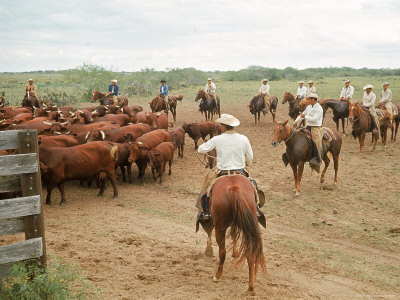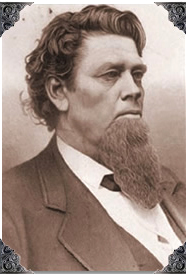
The King Ranch, located in south Texas between Corpus Christi and Brownsville, is one of the world’s largest and most famous ranches. The ranch itself is divided into four separate land areas (Laureles, Santa Gertrudis, Encino, Norias) of approximately 1,300 square miles. King had a life long motto “buy land, never sell”.
James Clement Jr., a great great grandson of founder Richard King, is Chairman of the Board and Jack Hunt, Harvard Business School graduate, is the CEO. The cattle operation (43,500 head) is run by Dave DeLaney.
 Richard King grew up in New York but stowed away on a ship going to the Alabama area. From the ranch website: “He found jobs in the shipping industry. After moving to South Texas, he founded a steam boat line with his lifelong friend Mifflin Kenedy – setting up ports and moving goods and people along the lower Rio Grande River. In 1853 he and business partner Gideon “Legs” Lewis purchased the 15,500-acre Mexican land grant then known as the Rincon de Santa Gertrudis – the first foothold of what would become the legendary King Ranch of Texas.
Richard King grew up in New York but stowed away on a ship going to the Alabama area. From the ranch website: “He found jobs in the shipping industry. After moving to South Texas, he founded a steam boat line with his lifelong friend Mifflin Kenedy – setting up ports and moving goods and people along the lower Rio Grande River. In 1853 he and business partner Gideon “Legs” Lewis purchased the 15,500-acre Mexican land grant then known as the Rincon de Santa Gertrudis – the first foothold of what would become the legendary King Ranch of Texas.
From their website: “The 1860s were busy, challenging years for Richard King and his new bride Henrietta, the refined daughter of Presbyterian minister from back East. This refinement would become a hallmark of the remote ranch as weary wayfarers found, over the years, not only an impressive ranching operation, but an oasis of gentility and warm hospitality in the very midst of an otherwise wild and often hostile country.”
Hearing there were cattle for sale in Mexico, King went to Cruillas. Again from the website: “The townspeople were in such dire straits that they sold all of their cattle to him in an attempt to survive the drought. A short distance out of town, slowly driving the cattle north toward Texas, Captain King realized that, in solving an immediate problem for the people of Cruillas, he had simultaneously removed their long-term means of livelihood. He turned his horse back toward the town and made its people a proposition. He would provide them with food, shelter and income if they would move and come to work on his ranch. The townspeople conferred and many of them agreed to move north with Captain King.

“Already expert stockmen and horsemen, these resilient denizens of the rugged Mexican range became known as Los Kineños – King’s people. They and many generations of their heirs would go on to weave a large portion of the historical tapestry of King Ranch. The expert Kineño cowboys now occupy a justifiably legendary place in the annals of the taming of the vast American West. The mystique of the Kineños is alive and well, and descendants of the original Cruillas residents still live and work on the ranch today – providing a vital link with the past and giving the ranch a key aspect of its unique atmosphere….
 “Around this time, Captain King registered a brand that has since taken on mythic significance in the taming of the West – the famous “Running W”.
“Around this time, Captain King registered a brand that has since taken on mythic significance in the taming of the West – the famous “Running W”.
“One of Captain King’s most important contributions to his ranch’s improvement was the outworking of his vision to improve his cattle and horse stock through an aggressive, thorough and studied upbreeding (breed improvement) program. By means of this program, King began to transform the hardscrabble longhorns and wild horses of his lands into the finest cattle and horses in Texas. Scientific upbreeding programs have been hallmarks of King Ranch since its inception, and they have paid off in spades. The upshot of one such program in the years after King’s death would be the development of the Santa Gertrudis breed of cattle – the first officially recognized new breed of beef cattle in America.”

The family grew and with it the business. When King died he owned half a million acres and was the wealthiest man in Texas. His grandson Robert Kelberg built the business into a 15 million acre empire with ranches from Argentina to Australia.
The website: “Oil and gas royalties drove another growth spurt for King Ranch during this period. After World War II, the ranch’s agricultural business was extended, in part to expand the national and global presence of the Santa Gertrudis breed. Acquisitions came through the purchase of property in Kentucky, Pennsylvania, Mississippi, and West Texas, and through joint ventures and partnerships in Florida. Management developed ranching operations overseas with land purchases in Argentina, Cuba, Brazil, Australia, Venezuela, Spain, and Morocco. The systematic and ambitious expansion of this period – in agriculture, energy, and real estate, together with expanded retail operations – created the platform for the business segments of King Ranch today.”
There were tough times as in any family business and in the 1970s there were family feuds, changing markets, massive debt, lawsuits, family members living away from the ranch and not involved with management. As the ranch moved from a family run to a professionally run operation things turned around and today it is a highly successful business.
The King Ranch operation raises outstanding horses, cattle, does farming (especially with citrus), has a publishing arm, a hardware business, a tack and saddle business, several training institutions and provides hunting opportunities. Whew! Diversity is obviously important to these folks!
You can get more information at the King Ranch Website.
